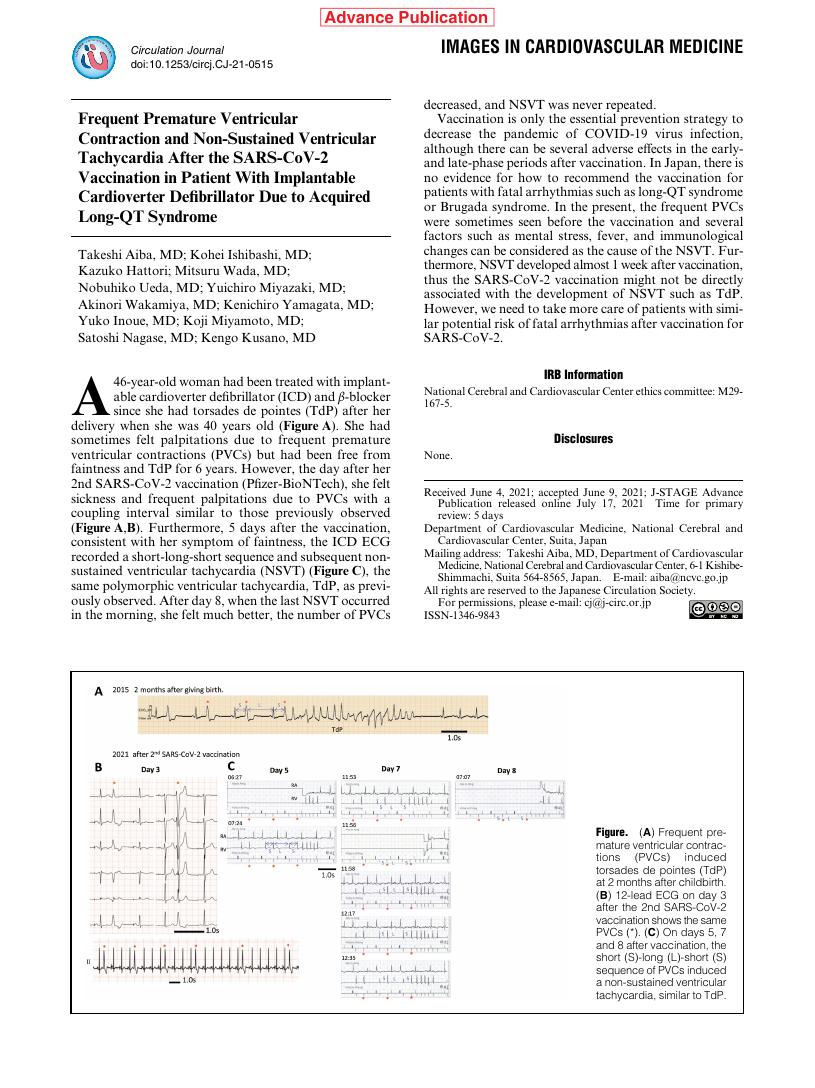- 著者
- Takeshi Aiba Kohei Ishibashi Kazuko Hattori Mitsuru Wada Nobuhiko Ueda Yuichiro Miyazaki Akinori Wakamiya Kenichiro Yamagata Yuko Inoue Koji Miyamoto Satoshi Nagase Kengo Kusano
- 出版者
- The Japanese Circulation Society
- 雑誌
- Circulation Journal (ISSN:13469843)
- 巻号頁・発行日
- pp.CJ-21-0515, (Released:2021-07-17)
- 被引用文献数
- 6
- 著者
- Nobuhiko Ueda Takashi Noda Koshiro Kanaoka Yuichiro Miyazaki Akinori Wakamiya Kenzaburo Nakajima Tsukasa Kamakura Mitsuru Wada Kenichiro Yamagata Kohei Ishibashi Yuko Inoue Koji Miyamoto Satoshi Nagase Takeshi Aiba Hideaki Kanzaki Chisato Izumi Teruo Noguchi Satoshi Yasuda Kengo Kusano
- 出版者
- The Japanese Circulation Society
- 雑誌
- Circulation Journal (ISSN:13469843)
- 巻号頁・発行日
- pp.CJ-23-0547, (Released:2023-12-05)
- 参考文献数
- 27
Background: Atrial tachyarrhythmias (ATAs) are reportedly associated with ventricular arrhythmias (VAs). However, little is known about the association between ATA duration and the risk of VA. We investigated the relationship between ATA duration and subsequent VA in patients with a cardiac resynchronization therapy defibrillator (CRT-D).Methods and Results: We investigated associations between the longest ATA duration during the first year after cardiac resynchronization therapy (CRT) implantation and VA and VA relevant to ATA (VAATA) in 160 CRT-D patients. ATAs occurred in 63 patients in the first year. During a median follow-up of 925 days from 1 year after CRT implantation, 40 patients experienced 483 VAs. Kaplan-Meier analysis showed a significantly higher risk of VA in patients with than without ATA in the first year (log rank P=0.0057). Hazard ratios (HR) of VA (HR 2.36, 2.10, and 3.04 for ATA >30s, >6 min and >24 h, respectively) and only VAATA (HR 4.50, 5.59, and 11.79 for ATA >30s, >6 min and >24 h, respectively) increased according to the duration of ATA. In multivariate analysis, ATA >24 h was an independent predictor of subsequent VA (HR 2.42; P=0.02).Conclusions: Patients with ATA >24 h in the first year after CRT had a higher risk of subsequent VA and VAATA. The risk of VA, including VAATA, increased with the longest ATA duration.
- 著者
- Fuminori Komai Kanako Okada Yuko Inoue Mitsunori Yada Osamu Tanaka Susumu Kuwabata
- 出版者
- 園芸学会
- 雑誌
- Journal of the Japanese Society for Horticultural Science (ISSN:18823351)
- 巻号頁・発行日
- pp.MI-008, (Released:2014-09-23)
- 被引用文献数
- 1 5
Mature pollen grains of Lilium cultivar, with their germ pores folded in upon themselves, were observed under a scanning electron microscope (SEM). The conventional pretreatment process requires aldehyde fixation, dehydration, drying and metal sputtering for SEM observation. These complicated and laborious procedures can considerably alter the morphology of pollen grains. In order to omit this conventional pretreatment process, we established a novel technique utilizing an ionic liquid (IL) that is composed solely of ions, namely, a liquid salt that can remain in a molten state even at room temperature. IL-treated pollen grains could be observed under vacuum conditions without artifacts, and furthermore, a satisfactory SEM image could visualize pollen grains in a wet state. The possible direction of future studies on ionic liquids in the SEM field is also discussed.
- 著者
- Hiroyuki Kamada Kazuki Mori Nobuhiko Ueda Akinori Wakamiya Kenzaburo Nakajima Tsukasa Kamakura Mitsuru Wada Kohei Ishibashi Kenichiro Yamagata Yuko Inoue Koji Miyamoto Satoshi Nagase Takashi Noda Chisato Izumi Teruo Noguchi Kengo Kusano Takeshi Aiba
- 出版者
- International Heart Journal Association
- 雑誌
- International Heart Journal (ISSN:13492365)
- 巻号頁・発行日
- vol.63, no.5, pp.828-836, 2022-09-30 (Released:2022-09-30)
- 参考文献数
- 29
The efficacy of direct current (DC) cardioversion before catheter ablation (CA) for persistent atrial fibrillation (PerAF) patients remains controversial. We hypothesized that maintenance of sinus rhythm (SR) by pre-ablation DC cardioversion may predict the outcome of CA in patients with PerAF. A total of 383 PerAF patients with no or mild symptoms (EHRA I/II) who had undergone DC cardioversion before CA (301 males, 65 ± 10 years old, mean atrial fibrillation (AF) duration: 25 ± 47 months) were retrospectively enrolled. Whether or not SR was maintained at least 24 hour after DC cardioversion, patients were divided into two groups, namely, the DC-SR group and DC-AF group, and then all were followed until AF recurrence after CA. After DC cardioversion, 281 (73%) patients were categorized into the DC-SR group, and 102 (27%) were categorized into the DC-AF group. A total of 195 patients underwent CA at an average of 83 (54-145) days after DC cardioversion, including 161 (83%) in the DC-SR group and 34 (17%) in the DC-AF group. During follow-up (median: 15 [10-25] months), the number of patients who were free from AF was significantly higher in the DC-SR group compared with the DC-AF group (61.5% versus 38.3%, P < 0.0001). Multivariate analysis revealed that the DC-SR group (hazard ratio [HR]: 0.45, 95% confidence interval [CI]: 0.21-0.99, P = 0.047) and age at first AF diagnosis (HR: 0.95, 95% CI: 0.91-1.00, P = 0.039) were the independent predictors for being AF-free after CA. In conclusion, the 24-hour rhythm outcome of pre-ablation DC cardioversion and age at first AF diagnosis may predict the recurrence of AF after CA in patients with PerAF.
